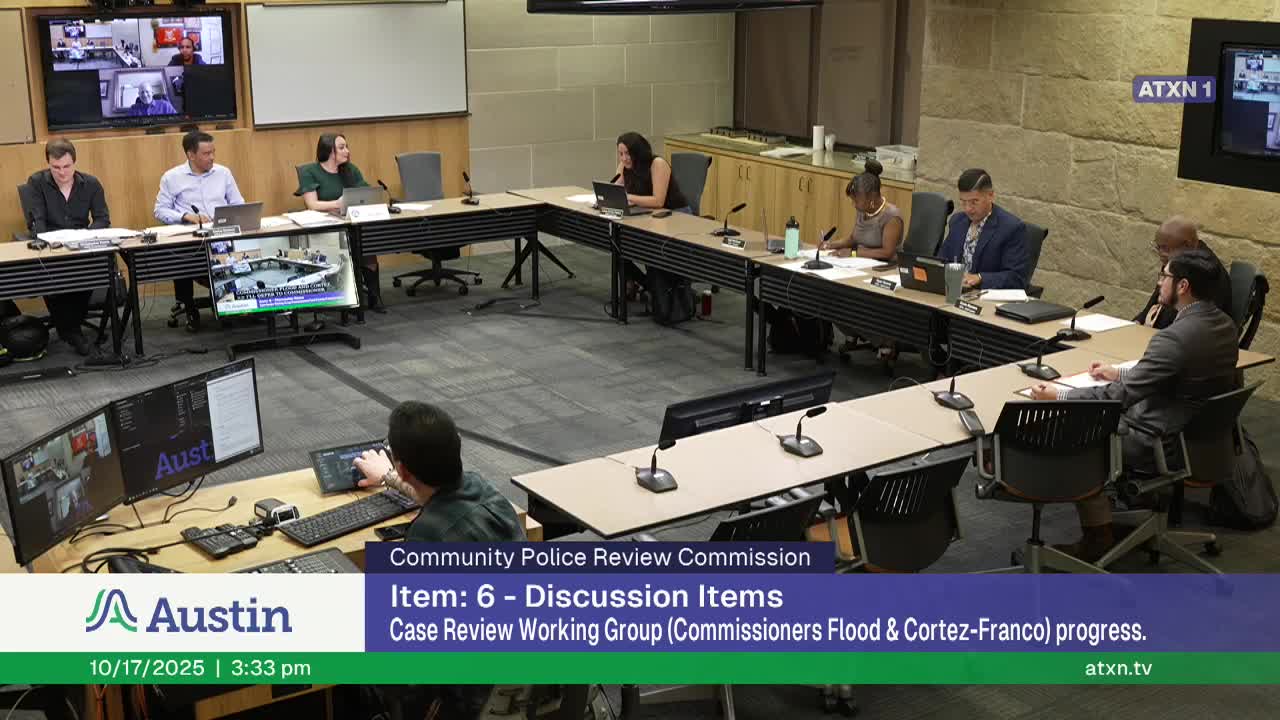CPRC working groups begin triage of roughly 90 case summaries; prioritize high‑interest and time‑sensitive matters
October 17, 2025 | Austin, Travis County, Texas
This article was created by AI summarizing key points discussed. AI makes mistakes, so for full details and context, please refer to the video of the full meeting. Please report any errors so we can fix them. Report an error »

Commissioners on Oct. 17 described early-stage work to triage complaints and investigation summaries that the Community Police Review Commission has received. Commissioners Laura Cortes Franco and Terry Flood said they have started a multi-step prioritization, are about halfway through roughly 90 case summaries, and have created a scoring system to rank cases by urgency and public interest.
Flood and Cortes Franco described a live spreadsheet in which they assign values to factors including severity, public interest, age of the case and risk of statutory or administrative deadlines. They said they have identified an initial set of highest-priority matters—referred to in discussion as “5, 4 and 3” cases—and plan to assign smaller review working groups to examine case files in detail.
Commissioners said the work is time-consuming: the two sample training cases they examined previously each required hours of review to parse dozens of documents and videos. They said the commission will rely on internal affairs and the Office of Police Oversight summaries; commissioners do not conduct investigations but review completed investigative files and may make recommendations based on those reviews.
Commissioners also discussed how to handle high-profile incidents that attract immediate public attention. They noted that the commission can review a case only after a formal complaint/investigation triggers an internal affairs review; internal affairs’ pace determines when summaries reach the commission. Commissioners said they received an Instagram video over the weekend and immediately flagged it to triage leads, but emphasized that a formal report and internal-affairs investigation are the procedural triggers that produce reviewable materials.
Training: commissioners said the clerk’s office will provide initial training in early November and that additional sessions with APD/IA will be scheduled to help commissioners understand investigative procedures and evidence.
Next steps: commissioners plan to finish the triage spreadsheet, divide into smaller review groups that will perform in-depth reviews, and publish how they prioritize cases so the public can understand the commission’s process.
Flood and Cortes Franco described a live spreadsheet in which they assign values to factors including severity, public interest, age of the case and risk of statutory or administrative deadlines. They said they have identified an initial set of highest-priority matters—referred to in discussion as “5, 4 and 3” cases—and plan to assign smaller review working groups to examine case files in detail.
Commissioners said the work is time-consuming: the two sample training cases they examined previously each required hours of review to parse dozens of documents and videos. They said the commission will rely on internal affairs and the Office of Police Oversight summaries; commissioners do not conduct investigations but review completed investigative files and may make recommendations based on those reviews.
Commissioners also discussed how to handle high-profile incidents that attract immediate public attention. They noted that the commission can review a case only after a formal complaint/investigation triggers an internal affairs review; internal affairs’ pace determines when summaries reach the commission. Commissioners said they received an Instagram video over the weekend and immediately flagged it to triage leads, but emphasized that a formal report and internal-affairs investigation are the procedural triggers that produce reviewable materials.
Training: commissioners said the clerk’s office will provide initial training in early November and that additional sessions with APD/IA will be scheduled to help commissioners understand investigative procedures and evidence.
Next steps: commissioners plan to finish the triage spreadsheet, divide into smaller review groups that will perform in-depth reviews, and publish how they prioritize cases so the public can understand the commission’s process.
View full meeting
This article is based on a recent meeting—watch the full video and explore the complete transcript for deeper insights into the discussion.
View full meeting
